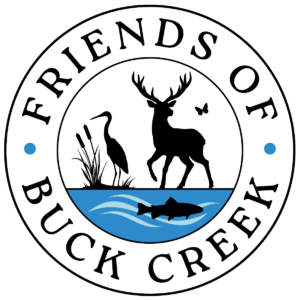We are all connected by the water that flows past us over our yards and streets and into the storm drains and roadside ditches. Here are some simple ways you can reduce pollution and help keep Buck Creek watershed clean and healthy.
Plant native plants
The deep root systems of native plants increase the soil’s capacity to store water and can reduce flooding and polluted stormwater runoff. Another great option is to install a rain garden in your yard!
Reduce Use of Fertilizers
Test your soil first to make sure you only apply what your lawn needs. Excess fertilizer can be washed away when it rains and end up in the creek. Phosphorus from fertilizers can cause algae blooms. Use only low-phosphorus or phosphorus-free fertilizers. Tips on reducing fertilizer use are available from the MSU Extension at https://www.canr.msu.edu/resources/fertilizing-home-lawns-to-protect-water-quality
Pick Up Pet Waste
Animal waste contains nitrogen and bacteria and can wash into storm drains and ditches when it rains, ultimately ending up in local rivers and creeks and causing pollution. You can help by picking up after your pet on walks and in your backyard.
Keep Leaves and Grass Clippings On the Lawn
Lawn clippings and leaves contain nitrogen. When these items are blown into the street and down the drain, they can pollute the stormwater that eventually reaches the Grand River. Leaving clippings on the lawn keeps those nutrients in your yard as a natural fertilizer. Leaves should be bagged, not blown, and can also be composted.
Use a Commercial Car Wash
Commercial car washes are required to properly dispose of wastewater. At home, soapy water runs from your car into the nearest storm drain. If you do wash the car at home, wash it on a pervious surface like grass (i.e. not your driveway or the street) and use a nontoxic and phosphate-free soap.
Dispose of Chemicals and Medications Properly
Never pour used oil or antifreeze into the storm drain or the street. Don’t pour toxic household chemicals down the drain either; take them to a hazardous waste center. To limit pharmaceutical contamination of waterways, take advantage of drug take back programs and learn how to properly dispose of medications. Locally, all Meijer pharmacies are DEA authorized drug collection sites and offer on-site drug take back kiosks.
Be Smart About Deicing
Rock salt (technically known as sodium chloride) is the most commonly used deicer, but contains cyanide, an anti-caking agent that can be toxic to underwater life. Only use what is necessary for safety in order to reduce stormwater pollution or consider using an alternative deicer that has fewer negative impacts. Check out these watershed-friendly deicing tips from Penn State Extension.



